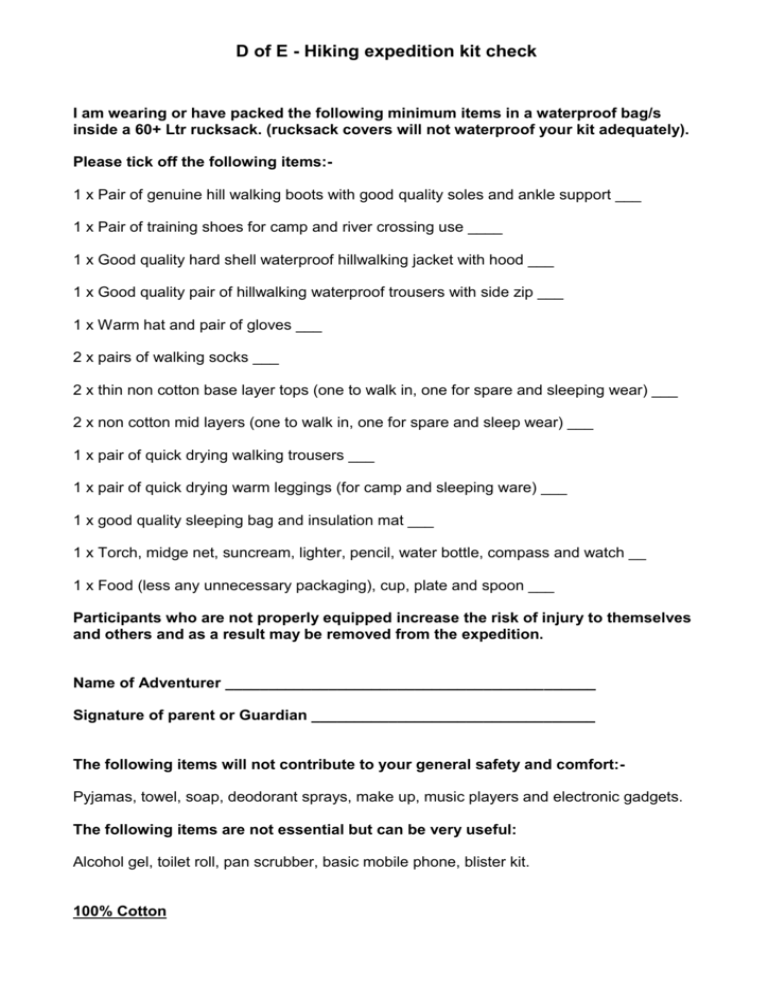Hiking Exped Kit Check
advertisement

D of E - Hiking expedition kit check I am wearing or have packed the following minimum items in a waterproof bag/s inside a 60+ Ltr rucksack. (rucksack covers will not waterproof your kit adequately). Please tick off the following items:1 x Pair of genuine hill walking boots with good quality soles and ankle support ___ 1 x Pair of training shoes for camp and river crossing use ____ 1 x Good quality hard shell waterproof hillwalking jacket with hood ___ 1 x Good quality pair of hillwalking waterproof trousers with side zip ___ 1 x Warm hat and pair of gloves ___ 2 x pairs of walking socks ___ 2 x thin non cotton base layer tops (one to walk in, one for spare and sleeping wear) ___ 2 x non cotton mid layers (one to walk in, one for spare and sleep wear) ___ 1 x pair of quick drying walking trousers ___ 1 x pair of quick drying warm leggings (for camp and sleeping ware) ___ 1 x good quality sleeping bag and insulation mat ___ 1 x Torch, midge net, suncream, lighter, pencil, water bottle, compass and watch __ 1 x Food (less any unnecessary packaging), cup, plate and spoon ___ Participants who are not properly equipped increase the risk of injury to themselves and others and as a result may be removed from the expedition. Name of Adventurer ___________________________________________ Signature of parent or Guardian _________________________________ The following items will not contribute to your general safety and comfort:Pyjamas, towel, soap, deodorant sprays, make up, music players and electronic gadgets. The following items are not essential but can be very useful: Alcohol gel, toilet roll, pan scrubber, basic mobile phone, blister kit. 100% Cotton D of E - Hiking expedition kit check Cotton when dry is warm and comfortable against the skin. Cotton readily absorbs large amounts of moisture from rain, streams and sweat. Cotton takes a very long time to dry out. This can’t be achieved whilst hiking. Cotton, when wet, takes large amounts of heat away from the body as it attempts to dry. 100% Cotton trousers, t shirts and hoodies must not be brought on expedition. 100% Polyester Polyester resists moisture and can provide an effective thermal barrier even when wet. Polyester is used extensively in outdoor garments such as thermal fleece. Polyester is used extensively in sports clothing and makes an effective base layer. Polyester if often made from recycled material. Polyester is the material of choice for effective moisture and thermal management. 100% Wool Wool resists moisture and can provide an effective thermal barrier even when wet. Wool from Marino sheep are used to make thermal base layers and socks. Wool products are often expensive and can be itchy against the skin. Mixed material Polyester, cotton, wool, acrylic, elastane and nylon are examples of materials which can be mixed together to provide particular qualities to garments such as stretch, feel, and durability. The more cotton in the mix the more potential moisture in the garment. Check labels if unsure. Waterproof (hard shell outer layer) Waterproofs keep the wind and rain off our clothes and bodies and will reduce wind chill. Waterproof jackets must have hoods and be thick enough to work as hard shells. Waterproofs made from breathable fabrics reduce condensation on the inside. Waterproof trousers with side zips allow users to take them on/off without removing boots. Thermal Insulation When we work we warm up, when we stop we cool down. An adjustable layering system keeps us at the right temperature. Thermal insulation occurs when warm air is trapped in the fibers of the garment and between multiple layered garments. The ground draws heat away from the body. Better sleep mats = warmer campers. A lot of heat is lost through the head. A good hat prevents this during sleep and activity. Foot Wear Carrying heavy loads over rough ground increases the risk of damage to joints and feet. Most discomfort experienced whilst hiking is from tired blistered feet. Always have your boots fitted and be prepared to change them when feet grow. Breaking in boots and conditioning feet to wear them will minimise blistering. Walking socks and good insoles will improve a boots performance.




